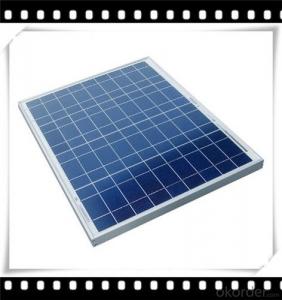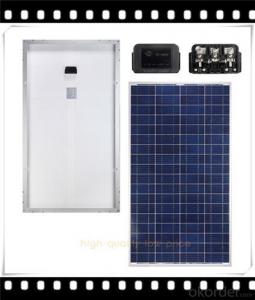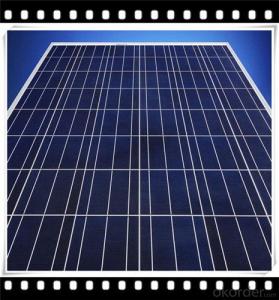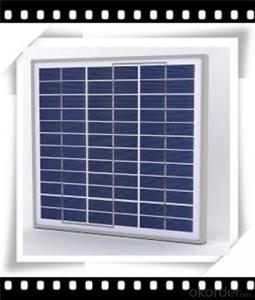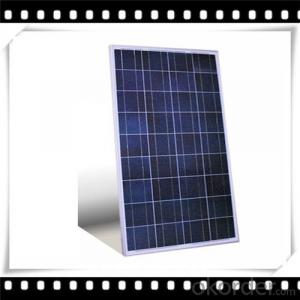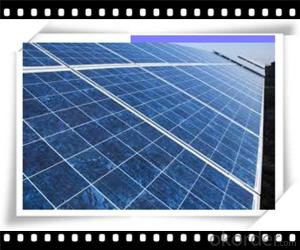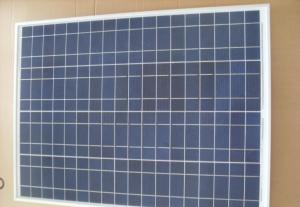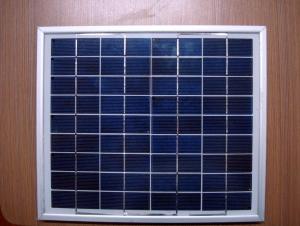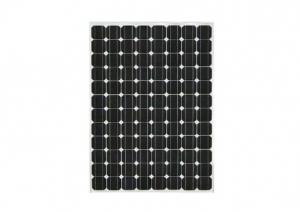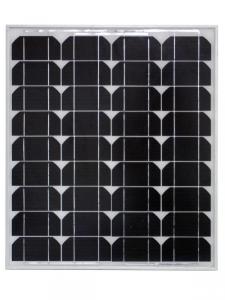80w BMW Poly Solar Panel Mini Solar Panel Newest Solar Panel CNBM
- Loading Port:
- Qingdao
- Payment Terms:
- TT OR LC
- Min Order Qty:
- 10 set
- Supply Capability:
- 300000 set/month
OKorder Service Pledge
OKorder Financial Service
You Might Also Like
Polycrystalline Solar Modules
CNBM offers a range of small, medium and large polycrystalline solar modules, designed for a range of requirements.


Specifications:
+/-3% |
Polycrystalline silicon solar cells (156 x 156mm) |
60 (10 x 6) |
1650 x 990 x 40 |
25.5 |
Limits:
Operating Temperature | -40~+85? |
Storage Temperature | -40~+85? |
Maximum System Voltage | 1000 VDC max. |
Hail Impact | Diameter of 28mm with impact speed |
Temperature and Coefficients:
NOCT | 48C+/-2? |
Voltage temperature coefficient (%/K) | -0.35 |
Current temperature coefficient (%/K) | 0.05 |
Power temperature coefficient (%/K) | -0.45 |
Characteristics:
Model: | SGM-200P | SGM-210P | SGM-220P |
Max-power voltage Vmp (V) | 29.2 | 29.4 | 29.41 |
Max-power current Imp (A) | 6.85 | 7.14 | 7.48 |
Open-circuit voltage Voc (V) | 36.5 | 36.69 | 36.9 |
Short-Circuit Current Isc (A) | 7.28 | 7.6 | 7.93 |
Max-power Pm(W) | 200 | 210 | 220 |
Model: | SGM-230P |
Max-power voltage Vmp (V) | 29.8 |
Max-power current Imp (A) | 7.72 |
Open-circuit voltage Voc (V) | 37.31 |
Short-Circuit Current Isc (A) | 8.19 |
Max-power Pm(W) | 230 |
STC: Irradiance 1000W/m2, module temperature 25?, AM-=1.5
Poly Crystalline Solar Panels Specifications Range
Maximum Power (Pm) | Dimension | Weight | Operating Voltage (Vmp) | Operating Current (Imp) | Open Circuit Voltage (Voc) | Short Circuit Current (Isc) |
0.45W | 140x80x10mm | 0.08kg | 3.3V | 150mA | 4.6V | 160mA |
1.0W | 162x140x10mm | 0.16kg | 7.5V | 150mA | 10.3V | 160mA |
4.5W | 269x251x23mm | 0.8kg | 16.5V | 0.27A | 20.5V | 0.3A |
10W | 420.1×268.9×22.6mm | 1.92kg | 17.5V | 0.58A | 20.5V | 0.6A |
20W | 425x502x50mm | 3.0kg | 16.8V | 1.19A | 21.0V | 1.29A |
30W | 593x502x22.6mm | 3.9kg | 16.8V | 1.78A | 21.0V | 1.94A |
40W | 655x537x50mm | 5.75kg | 17.3V | 2.31A | 22.1V | 2.54A |
50W | 839x537x50mm | 6.0kg | 17.5V | 2.9A | 21.8V | 3.17A |
65W | 1111x502x50mm | 7.2kg | 17.6V | 3.69A | 22.1V | 3.99A |
80W | 1204x537x50mm | 7.7kg | 17.6V | 4.55A | 22.1V | 4.8A |
- Q: So, I've seen cheap solar panel kits for sale from Harbor Freight, and regardless of whether or not I were to buy a set from them or someone else, I was wondering what the process of implementing a small-scale solar system into your household electrical system would be.I've read articles that started out too in-depth or were speaking of systems on a much larger scale.Can it be as easy as buying the panels and inverter, and plugging it into a socket, or is there more to it?Some of the articles I was reading had mentioned having to contract with your electrical supplier, having to have an electrician tie it all in in some special/ necessary way, using a battery pack (would this be necessary for a tied-in system?), or using the system to only power single items, like a water heater, or plugging items into a connected battery-pack, all of which I'm not sure is necessary or needed for what my goals/ means are/ would be.
- Grid tie inverters are expensive, but you might find a used one cheap on E-Bay, Crags list. Almost any grid tie inverter will work as you are thinking low power, but it likely needs to be 50 hertz or 60 hertz, which ever you have, and 230 volts ac or 20 volts ac which ever you have. It will work for a range of dc voltages, so your solar panels need to produce voltage near the center of that range. I considered buy the 3 PV panel set of 5 watt panels that Harbor freight sells. but I did not determine if the three panels can be conveniently connected in series to produce about 50 volts at light loads, or 00 volts if you buy two sets. You probably do not need the load controller, that comes with each set. I think most grid tie inverters automatically adjust to the dc voltage you supply them, unless it is below some minimum such as 50 volts. It is illegal to connect ordinary inverters to the power company, but they will probably not notice a small system unless you burn your house down. Most inverters will phase lock with the power companies frequency, but they are not designed to do that, so bad is likely unless you connect a resistor such as 0 ohms at 00 watts in series with the ac out of the inverter. If the resistor smokes you should disconnect promptly, then try again to see if you can get phase lock quickly. No smoke, likely means you are one of about 000 co-generators on the electric grid, You can short out the resistor with short piece of very fine wire which will hopefully melt if something goes wrong, such as the power company not sending electricity for 0. seconds or longer. Nearly all inverters have an over load feature, so the thin wire is a back up. Please be careful as people sometimes don't survive an electric shock at 20 volts.
- Q: Maximum size of solar panel i have to use is - 8 * 5 feet - this is the limitation given to us.
- If okorder . If you must store this energy, that's another trick involving other equipment.
- Q: Polycrystalline solar panels are good or single crystal solar energy is good
- From the cost of production, than the monocrystalline silicon solar cells to be cheaper, easy to manufacture materials, saving power consumption, the total cost of production is low, so get a lot of development. In addition, the polysilicon solar cell life than monocrystalline silicon solar cells shorter. From the performance and price ratio, monocrystalline silicon solar cells also slightly better.
- Q: Can solar panels be installed on outdoor event venues?
- Yes, solar panels can be installed on outdoor event venues. Solar panels are versatile and can be mounted on various surfaces, including rooftops, canopies, and even the ground. Installing solar panels on event venues can help generate clean and renewable energy, reducing reliance on traditional power sources and minimizing carbon emissions. Additionally, solar panels can provide shade and protect attendees from the sun, creating a more comfortable environment during outdoor events.
- Q: I know the basics of how solar panels work. Solar panels convert sunlight into DC electricity which is stored in batteries which would need to be run through an inverter to convert it to household AC. But is there a way for the appliances to use the solar panels electricity FIRST and any additional power from the grid? Is that how it works or do they only run specific devices(water heater, pool pump, etc)?
- The batteries are inefficient and expensive. Lead acid batteries are 95% efficient at discharging but only 50% efficient at charging so you need double your power consumption in solar panels for a battery based system. The big breakthrough was in grid tied inverters, these can be connected to the grid and synchronizes it's frequency to the grid thereby selling the solar power to the grid. The house electric system remains on the grid so you buy back the power when you need it effectively turning the grid into a 00% efficient battery by accounting. This saves you the cost of the batteries and the inefficiencies of the batteries halving the number of panels that you need. Grid tied solar can be a third the price of a comparable battery based system. The utilities will usually still have a service fee and may have limitations such as you can only sell the amount of power that you use and the sale can only be credits versus future energy purchases. There will also be the inefficiencies of the grid tied inverter but it would be at full load which is when it is the most efficient often 95% whereas the partial load use of a battery based system operates the inverter at an average of 65% efficiency which is why DC appliances are highly recommended for a battery based system.
- Q: Can solar panels be installed on streetlights?
- Yes, solar panels can be installed on streetlights. This allows the streetlights to generate their own electricity from sunlight, reducing reliance on the electrical grid and promoting sustainability.
- Q: Can solar panels be used to power a museum?
- Yes, solar panels can be used to power a museum. Solar panels convert sunlight into electricity, which can then be used to power various electrical systems and devices within the museum. The installation of solar panels on the museum's roof or surrounding areas can generate renewable energy, reducing the reliance on traditional energy sources and lowering carbon emissions. Additionally, solar power systems can provide a sustainable and cost-effective solution for powering a museum's lighting, climate control systems, and other electrical needs.
- Q: I wanna start going green, you know like solar panels, wind turbines, etc. but where I live the companies that install the free solar panels in exchange for the subsidiaries aren't available. To start off I was just looking for a single panel I could drill into my roof and wire it to an outlet just for small thinks like charging my phone and a fan maybe. If anybody can understand my crazy idea please answer with links to where I can find these things. Thanks!
- Q: Can solar panels be installed on a warehouse or industrial facility?
- Yes, solar panels can be installed on a warehouse or industrial facility. In fact, these types of large commercial buildings often have spacious rooftops that are ideal for hosting solar panels. Installing solar panels on warehouses and industrial facilities can help reduce electricity costs, generate clean energy, and contribute to sustainability efforts.
Send your message to us
80w BMW Poly Solar Panel Mini Solar Panel Newest Solar Panel CNBM
- Loading Port:
- Qingdao
- Payment Terms:
- TT OR LC
- Min Order Qty:
- 10 set
- Supply Capability:
- 300000 set/month
OKorder Service Pledge
OKorder Financial Service
Similar products
Hot products
Hot Searches
Related keywords
